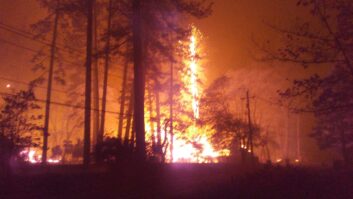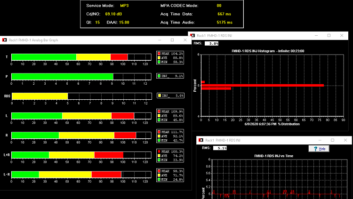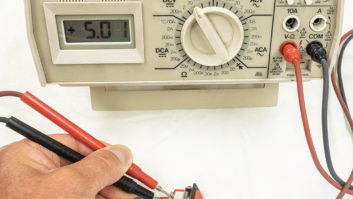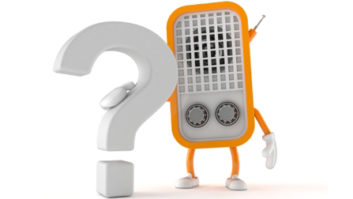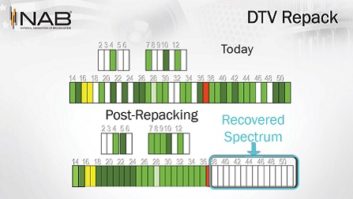Have you experienced underground cable failure? During my time as a chief, one station lost an underground feeder for the three-phase electrical service, silencing both AM and FM. With no generator, we were on exciter power while the utility laid new cable.
Oh, the repair could have been quicker, had they used a trencher the size of a tank. But the trencher would have ruined the ground system. I told the crew that electric current was flowing through the radials. No one wanted to get zapped, so they used an underground tunneler instead – saving the ground system.
(click thumbnail)Fig. 1: AM ground radials were damaged due to unauthorized digging.
Utilities aren’t always aware of what’s under the ground at your transmitter site. Avoid the mess seen in Fig. 1. Post “Do Not Dig” signs and plan to be on site for any utility work to help avert this kind of disaster.
Buc Fitch encountered this problem once again. No one had bothered to call Dig Safe, and so excavation for a new generator pad cut through the telco cable. This put the transmitter site off the air.
The problem got worse. It was the contractor’s fault, so the telco company didn’t view the damage as an emergency, so the station had to operate on a Marti for nearly a week until the problem was fixed.
Make it a habit to dial your local one-call number before any digging. You usually have to give them 48 hours’ notice, so don’t wait until the last minute.
In many places, (800) DIG-SAFE will get you to the right folks. You’ll find state-by-state listings online, for instance at www.digsafe.com/company_onecalldirectory.htm If you can’t find the appropriate resource, ask your power utility.

I used such a service when I was replacing tower base fencing. The utility company marked where the electrical feeder to each ATU was. Since this cable was run in a bundle with the RF and sampling line, the markings told the fencing contractor where he shouldn’t dig.
Buc adds an interesting color code that might be helpful. Occasionally you’ll find different colored lines spraypainted on the ground. Refer to the color code key in Fig. 2 to figure out what each color represents.
Thanks, Buc, for tips that may help prevent a cable disaster.
. . .
In addition to practicing law, Paul Christensen is an SBE CPBE and CBNT. Paul recalls a discussion concerning the use and lack of affordability of commercial-grade network analyzers for broadcast engineers. Given the power associated with the network analyzer, an affordable alternative would give broadcast engineers another valuable tool for making useful antenna system measurements.
While it’s not a commercial-grade product, Ten Tec is manufacturing a Virtual Network Analyzer that gives much of the same analytical power as a commercial-grade instrument at a fraction of the cost. For $655, the product is said to perform the same complex functions as a true network analyzer.
But, Paul writes, at that price-point there are going to be obvious performance sacrifices, like a maximum upper frequency limit of 120 MHz, only 80 dB of dynamic range, 30 dB return loss range and only +3 dBm output power. Still, there’s probably enough precision to offer good utility and accuracy for many measurements up to and including the FM broadcast band.
Visit http://radio.tentec.com and type TAPR into the search field.
. . .
(click thumbnail)Fig. 3: An economical ‘third hand’ for soldering.
Got a block of wood lying around the shop? Grab it, along with a fistful of connectors, and put together a connector solder-holder, as seen in Fig. 3.
Wes Boyd calls it another of his silly items, but when it comes to needing a third hand for soldering, who cares how it looks? It gets the job done.
He got the idea when he received a commercial version of this soldering fixture via BGS a few years ago. The BGS version was mounted to a nice aluminum block that could be held in a vise. Of course, someone walked away with it. So Wes grabbed a piece of 2×4, some Liquid Nails, a drill and some connectors to come up with his own version.
It works for A3M and A3F connectors, and the fixture will hold 1/8- and 1/4-inch plugs as well. And it’s all under budget.
By putting the tip-ring-sleeve 1/4- and 1/8-inch plugs toward the bottom, the block can be set on its end, so the plug is horizontal as you solder it.
Wes Boyd is market chief for Cumulus in Youngstown, Ohio.
. . .
We’ll wrap up with a reminder of a find that just may save your job.
We’ve written about interference problems. Many are intermittent and nearly impossible to track down. Not understanding the issues that surround interference, a GM quickly may lose confidence in your engineering abilities.
Dave Biondi’s Broadcast.net list serve comes to the rescue again. This time it’s C-band reception and airports that don’t mix. If you suffer from satellite reception dropouts, it may be an interfering signal blanking out your signal. Bobby Gray, who handles engineering for ESPN1080 in Orlando, is just one engineer who fixed the problem by heading to www.microwavefilter.com/tvrointerference.htm.
In addition to providing a variety of interference filters, Microwave Filter Co. has one of the best guarantees in the industry: If the filter doesn’t solve your problem, they’ll buy it back.
Thanks, Bobby, for the testimonial.






